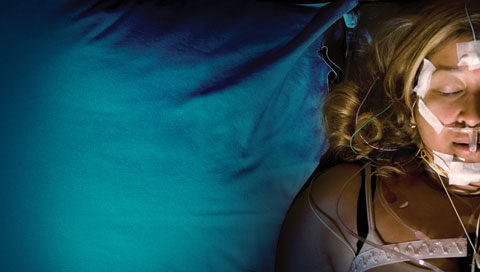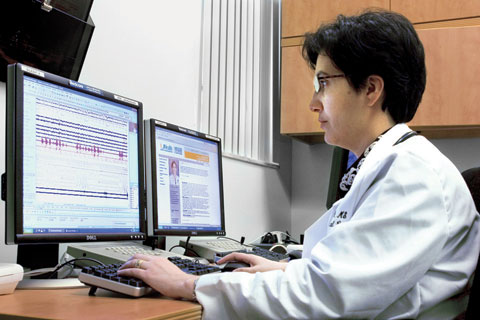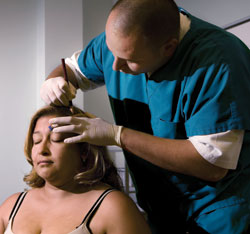Fulfilling the Dream of a Good Night’s Sleep
By Blair S. Walker | Photos by Richard Patterson
The UHealth Sleep Program helps patients suffering from sleep disorders while it moves forward to launch a research program to discover the causes of such conditions.
 |
| During a sleep study, patient Nelly Chavez is wired to EEG, EKG, oxygen, and breathing monitors and is recorded by an infrared TV camera. |
The sight of a vermilion sun dipping toward Miami’s western horizon used to fill Karen Sebastien with dread. That’s because darkness—and another terrifying bout of sleep paralysis—was on the way.
For her, sleep wasn’t a serene, restful experience. Instead, it was a spirit-sapping string of hallucinatory episodes that made bedtime a nightly ordeal.
“Sleep paralysis is when you fall asleep and your body sleeps, but not your brain,” explains Sebastien, an attractive woman whose accent reveals her northeastern European lineage and who asked that her likeness and real name not be used. “During sleep paralysis, your eyes are open, and you hear footsteps coming from the main door to the bedroom. You feel like someone is punching you! It’s not a dream, because you can feel the pain.
“There will be no bruises ... you will be screaming, and nobody can hear you,” Sebastien, 28, says of the ordeal she endured for 13 wearying years until her disorder was successfully treated at the UHealth Sleep Program, part of the University of Miami Health System.
Sebastien was diagnosed as suffering from narcolepsy, a chronic sleep disorder that’s one of several illnesses targeted by the UHealth Sleep Program, whose offices and four sleep-study suites are located in the National Parkinson’s Foundation building on the Miller School campus.
Clinical and research efforts devoted to sleep medicine are pretty much in their infancy, having only been around since the 1960s, notes UHealth Sleep Program director Dalia Lorenzo, M.D. Over the past two years, the Miller School has put a heightened emphasis on studying sleep.
“Sleep is hot!” Lorenzo says. “It has the potential to become a huge field. The area of sleep medicine has the potential to make very significant contributions to the research and treatment of many of the diseases that it impacts.”
UM’s immersion into sleep medicine began in earnest in 1990 at the behest of Bruce Nolan, M.D., F.A.C.P., the sleep program’s medical director. Since that time, “Sleep medicine has pretty much come into the mainstream of medical specialties,” says Nolan, whose background is in neurology and who’s board certified in sleep medicine. “People increasingly began to realize that there was a need to serve people who had common, and life-threatening, sleep disorders,” adds Nolan.
 |
| Pulmonologist Shirin Shafazand, M.D., monitors a computer screen displaying a sleep patient’s vital functions. |
The UHealth Sleep Program engages internists, otolaryngologists, psychiatrists, psychologists, pulmonologists, and neurologists. Last year the program also established a sleep-training fellowship approved by the Accreditation Council for Graduate Medical Education.
The push to learn more about what happens when we sleep and how that affects our overall health couldn’t have come at a better time for Sebastien, whose sleep paralysis episodes started when she was a 15-year-old in Europe. During the day, she was constantly exhausted and always taking naps.
“At first I thought it was a brain tumor,” says Sebastien, a matter-of-fact woman who’s devoid of self-pity. “But after four years I went, ‘Oh well, it’s not.’ Because if it was, it would have killed me.”
A big fan of horror movies as a teen, she thought they might have been the cause of her nightmarish sleep sessions and stopped watching them. The torture continued.
Compounding her misery, doctors in Sebastien’s home country misdiagnosed her malady. “I was a teenager, and they basically thought I was having a (psychiatric) crisis,” Sebastien remembers. “They gave me an antidepressant, and I didn’t take them. I just threw them away.”
Several times each night, as her hallucinations took hold, unseen tormentors accosted Sebastien, who would lie in bed cowering at the sound of approaching footsteps, unable to move. Her assailants routinely pummeled and cut her, prompting cries of pain that never made it past immobile vocal cords. Sebastien never thought she might be mentally unbalanced and never mulled suicide, although the nightly torture sessions did make her a nonbeliever.
“Thank God, I can say I became an atheist,” Sebastien says, oblivious to the inadvertent irony in her statement. “When you experience sleep paralysis, it’s like the devil attacking you. I didn’t want to open that door.”
She left Europe to attend college in the United States and got a job in Miami after earning her degree. She typically began workdays with four shots of espresso to stay alert and resorted to pinching herself during meetings to avoid nodding off.
“I started researching, trying to find out what was wrong,” Sebastien says.
Last September Sebastien visited the UHealth Sleep Program. Her physician, pulmonologist Shirin Shafazand, M.D., suspected she already knew the crux of Sebastien’s problems.
“I immediately thought of narcolepsy,” Shafazand says. “It was a combination of the excessive sleep during the day and sleep paralysis at night.
“Narcolepsy is a relatively rare disorder we think may be related to the absence of a certain neurotransmitter in the brain,” Shafazand says. Narcolepsy sufferers sometimes have sleep paralysis, which commonly triggers the kinds of hallucinatory episodes Sebastien endured.
She submitted to a sleep study, which called for an overnight stay in a UHealth Sleep Program suite while hooked to EEG, EKG, oxygen and breathing monitors, and being recorded by an infrared TV camera.
“I was happy to be diagnosed,” Sebastien says of the narcolepsy verdict. “I knew that I had all the symptoms, but I was not educated and entitled to make that decision.” Medications prescribed by Shafazand have vanquished Sebastien’s nighttime demons and done away with the daytime drowsiness.
Sebastien says the main reason she’s chosen to remain anonymous in this story is because of her employer.
“People will misunderstand it,” she says of her medical condition. “They will feel pity for you, but they will also feel that you are not fully functional, that you are heavily medicated, and you have a disorder that does not have a cure.
“And I don’t want that,” Sebastien says. “I don’t want that to get in between me and my job.”
Shafazand isn’t surprised by her patient’s quest for anonymity. “For things like narcolepsy, sleep walking, sleep talking, there definitely is a stigma attached to it,” Shafazand says. “It’s partially cultural, and it’s partially because you don’t want people to know that you have a condition that interferes with your concentration or ability to do your job.”
Narcolepsy, cataplexy—the field of sleep medicine is filled with interesting illnesses whose bodies of literature are currently being written, says Lorenzo.
Nothing else manages to be simultaneously ubiquitous and mysterious quite like sleep. Physicians and researchers know it plays an important role in terms of metabolism, learning, and memory, but they aren’t entirely sure how. Nor do they fully understand why we sleep or if the triggering mechanism is evolutionary.
According to the American Academy of Sleep Medicine, there are more than 70,000 physicians, researchers, and health care professionals nationwide focusing exclusively on sleep medicine.
 |
| Polysomnographic technologist Angel Cruz prepares patient Nelly Chavez for a sleep study. |
“If you look at the National Institutes of Health, they’re really pushing to look at sleep disorders and the intersection between that and other co-morbid diseases,” says Lorenzo.
“Our goal is to eventually become a sleep center of excellence,” Lorenzo says of the UHealth Sleep Program.
Lorenzo and her colleagues will likely be seeing a lot of patients like Carlos Porta. It had become a running joke among his buddies that “you don’t want this guy crashing in your house” because of the loudness of Porta’s snoring.
“I was told it wasn’t just loud, it was like I had stopped breathing,” relates Porta, 32, who works for a nonprofit and takes college business classes in the evenings. “I was waking up a few times in the middle of the night. And I just noticed that throughout the day, I wasn’t feeling refreshed or rested. I just was constantly sleepy.”
Unlike Sebastien, Porta had a pretty good idea what his problem was. His father, Carlos, had experienced similar problems and was directed to the UHealth Sleep Program. The older Porta had been diagnosed as having obstructive sleep apnea, a sleep disorder characterized by interrupted breathing.
“When you stop breathing and oxygen levels go down, your autonomic nervous system—what’s called your fight-or-flight system—goes into overactive mode,” explains UHealth Sleep Program neurologist Douglas Wallace, M.D., who treated the younger Porta. “All your organs are not getting enough oxygen, so your heart races and your blood pressure shoots way up, and your body’s trying to get you to wake up. The whole night it’s like you’re on a stress test, because your heart is going up and down, up and down, and your blood pressure is going up and down, up and down.”
During one of two sleep sessions, Porta was fitted with a continuous positive airway pressure (CPAP) mask that pushes air into his lungs at mild pressure. Finally able to get an uninterrupted night’s sleep, Porta dreamed for the first time in eons.
“My dream was very, very vivid, and the next morning I felt very refreshed,” he remembers. “And I said, ‘Whoa, man! Whoa!’ It felt like I was on some type of high. It was weird, but it was good,” Porta laughs. “I said, ‘Man, I need to take this mask home right now!’”
He was given a five-pound CPAP unit and mask for home use, lessening his risk of eventually being treated for Type 2 diabetes and stroke, and improving his stamina, mental outlook, and short-term memory.
“All the research that is coming out is pointing to sleep having a big impact on lots of areas of health,” Lorenzo says. “Tell me how many people you know who have not had a problem with their sleep? Sleep is a very basic drive, just like the drive to eat.” |


